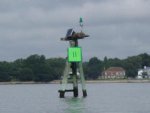vinnie1234
Petty Officer 2nd Class
- Joined
- Jul 7, 2014
- Messages
- 161
Hello all. I am new to boating and have recently acquired a 1978 crestliner crusader bowrider. It iis 17.75 feet long with a deep v hull. Seems to have a decent amount of deadrise and as it is fibreglass it has a nicely flared hull to deflect water. I have had it out in some chop (3foot waves, short intervals maybe 2 sec).
Anyway, as a new mariner I am not entirely sure what constitutes rough or dangerous water conditions with this boat. I felt quote comfortable in the chop, even though there was the occasional "slam" while on plane.
I was wondering if any of you folks have owned a boat like this and can offer me some feedback as to what can be done in rough water. I realize that some of this depends on the skipper (me) and I have been diligent in researching the correct way to handle a boat in adverse conditions.
My plan is to take the boat out in calm waters and gradually step up to boating in heavier weather. This way I can afford to make some small errors and gain some experience.
What I don't want to do is go out in some rough-ish water and then find out that the waves come over the bow and over the transom and swallow my damn boat. So I guess I am looking for some guidelines to use as a noob, and also an idea of what the boat would be capable of with an experienced skipper (me, after a few years).
The thing that gets me is that there are many varying stories about small 16-18 foot boats. Some guys take these things out in big water without incident and other guys say that a 3 foot wave will swallow you whole.
Wave intervals in my area seem to range from 2.0 sec to 5 sec. Wave height seem to average around 3 feet.
So, if any of you can satisfy my curiosity and desire to learn, it would be greatly appreciated.
Anyway, as a new mariner I am not entirely sure what constitutes rough or dangerous water conditions with this boat. I felt quote comfortable in the chop, even though there was the occasional "slam" while on plane.
I was wondering if any of you folks have owned a boat like this and can offer me some feedback as to what can be done in rough water. I realize that some of this depends on the skipper (me) and I have been diligent in researching the correct way to handle a boat in adverse conditions.
My plan is to take the boat out in calm waters and gradually step up to boating in heavier weather. This way I can afford to make some small errors and gain some experience.
What I don't want to do is go out in some rough-ish water and then find out that the waves come over the bow and over the transom and swallow my damn boat. So I guess I am looking for some guidelines to use as a noob, and also an idea of what the boat would be capable of with an experienced skipper (me, after a few years).
The thing that gets me is that there are many varying stories about small 16-18 foot boats. Some guys take these things out in big water without incident and other guys say that a 3 foot wave will swallow you whole.
Wave intervals in my area seem to range from 2.0 sec to 5 sec. Wave height seem to average around 3 feet.
So, if any of you can satisfy my curiosity and desire to learn, it would be greatly appreciated.




















